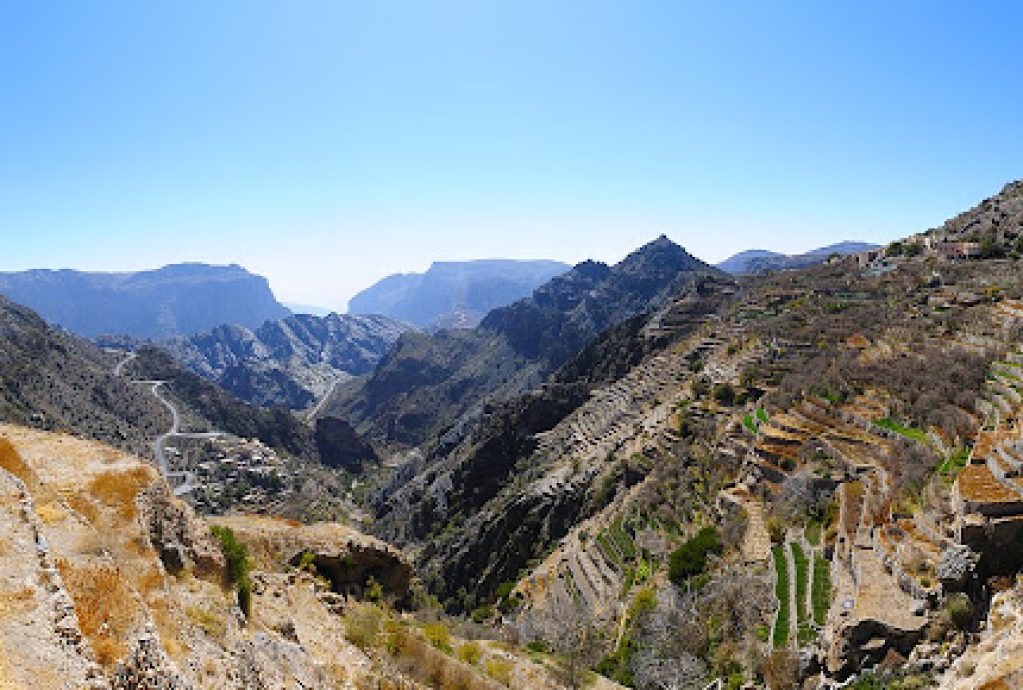Jebel Akhdar: Oman’s Mountain Paradise Discover the breathtaking beauty of Jebel Akhdar, the “Green Mountain” of Oman. Renowned for its terraced farms, fragrant rose gardens, and dramatic canyons, this highland retreat offers a refreshing escape with its cool climate and stunning vistas. Whether you’re exploring ancient villages or trekking scenic trails, Jebel Akhdar promises an unforgettable adventure. Let LetsOman.com be your guide to this natural wonder, where tradition and nature blend in perfect harmony.
- 2PH2+F3M, Saiq, Oman
- Entry Fee : Free
- Opene 24 hours


Jebel Akhdar: Oman’s Majestic Green Mountain
Overview
Jebel al Akhdar translates as “The Green Mountain”, and it truly lives up to its name as one of Oman’s most spectacular natural destinations. Rising majestically from the Hajar Mountain range, this stunning plateau sits at an elevation of about 2000m above sea level, offering visitors a cool respite from Oman’s desert heat and an unforgettable mountain experience.
Located approximately 45 minutes from Nizwa, Jebel Akhdar is renowned for its dramatic landscapes, ancient agricultural terraces, fragrant rose gardens, and traditional mountain villages. The region’s unique climate and altitude create perfect conditions for traditional rose water extraction and agricultural products including pomegranates, walnuts, apricots, black grapes, and peaches.
Best Time to Visit
The most enchanting time to visit Jebel Akhdar is during the rose blooming season. Every spring, from mid-March until May, the surrounding slopes transform into a riot of colour with an abundance of indigenous pink Damask roses that burst into full bloom. This spectacular display creates a vivid tapestry across the mountainsides and fills the air with the intoxicating fragrance of roses.
For budget-conscious travelers, consider visiting between June and August, when hotel prices are generally the lowest, though you’ll miss the famous rose season.
Top Attractions & Activities
Diana’s Point
Diana’s Point is a famous viewing point made famous by the late Lady Diana. This spectacular vantage point offers breathtaking panoramic views of the surrounding canyons and valleys. Visitors can enjoy picnic lunches and easy hikes around the perimeter of the canyon, making it perfect for photography and contemplation.
Rose Gardens & Rose Water Production
The heart of Jebel Akhdar’s agricultural heritage lies in its famous rose gardens. Visitors can tour the rose gardens and processing factory where traditional Omani rose water is manufactured. Experience rose-water distilleries where the ancient art of extracting precious rose oil continues, creating products that have been treasured for centuries.
Traditional Mountain Villages
Explore charming traditional villages like Balad Sayt and Al Ayn, where time seems to have stood still. These settlements showcase traditional Omani mountain architecture and provide glimpses into the region’s rich cultural heritage. Perfect views of 3 active villages cultivating various fruits, vegetables and flowers on terraced fields offer insight into the ingenious agricultural systems that have sustained life here for generations.
Agricultural Terraces
The ancient terraced farming system is a marvel of engineering and agriculture. Discover hidden wadis and terraces where apricots, pomegranates, walnuts and roses all flourish in cooler, high-altitude temperatures. These terraces demonstrate centuries-old sustainable farming practices perfectly adapted to the mountain environment.
Hiking & Nature Trails
The Green Mountain offers magnificent hikes and trails through ancient villages. Popular hiking routes include:
- The Rose Trail connecting traditional villages
- Terrace farm walks through Al Ayn villages
- Canyon rim trails with stunning valley views
- Juniper forest explorations at higher elevations
What Makes Jebel Akhdar Special
Unique Climate
The high altitude creates a remarkably different climate from the rest of Oman, with cooler temperatures year-round and occasional winter frost. This unique microclimate supports vegetation rarely found elsewhere in the region.
Agricultural Heritage
The area is known for its traditional rose water extraction and is also the site of honey bee breeding for much of Oman. The sustainable farming practices here represent thousands of years of agricultural innovation.
Biodiversity
As the seat of many magnificent species of flora and fauna, Jebel Akhdar supports unique ecosystems that thrive in the mountain environment, including rare plants and endemic species.
Photography Opportunities
Jebel Akhdar is a photographer’s paradise offering:
- Sunrise and sunset views over dramatic mountain landscapes
- Terraced gardens creating geometric patterns on hillsides
- Traditional architecture in ancient villages
- Rose gardens in full bloom during spring
- Star-filled night skies with minimal light pollution
- Panoramic canyon and valley vistas
Practical Information
Getting There
- Located approximately 45 minutes from Nizwa
- A tarmac road leads to the top with dirt roads leading to magnificent views
- 4WD vehicle recommended for exploring off-road viewpoints
- Well-signposted main routes prevent getting lost
What to Bring
- Camera with fully charged batteries
- Comfortable hiking shoes
- Water for hiking excursions
- Light jacket for cooler mountain temperatures
- Sun protection despite the altitude
Accommodation
The area offers various accommodation options, from luxury mountain resorts to traditional guesthouses, allowing visitors to fully immerse themselves in the mountain experience.
Cultural Significance
Jebel Akhdar represents the perfect harmony between human ingenuity and natural beauty. The traditional farming techniques, rose cultivation, and architectural styles found here offer visitors authentic insights into Omani mountain culture that has remained largely unchanged for centuries.
Whether you’re seeking adventure, tranquility, cultural immersion, or simply spectacular scenery, Jebel Akhdar delivers an unforgettable experience that showcases the diverse beauty of Oman’s landscapes and the resilience of its mountain communities.